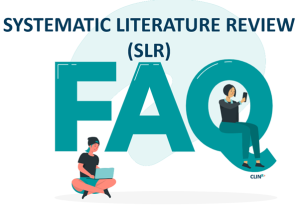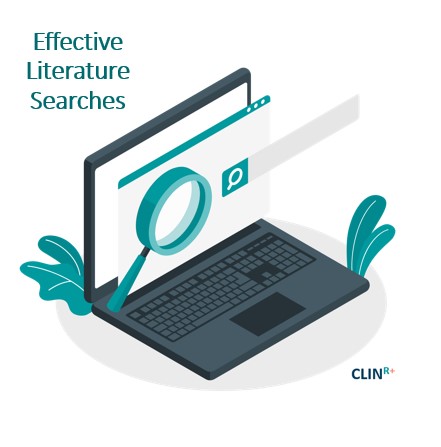Systematic Literature Review (SLR) FAQ

Q: Why do you need effective literature searches for medical devices to comply with regulations like the MDR?
A: Effective literature searches are crucial for medical devices to gather adequate clinical evidence for compliance with essential safety and performance requirements. They form a vital part of a comprehensive Clinical Evaluation and help demonstrate the device’s clinical safety and performance.
Q: What are the key components of a literature search process for medical devices?
A: The literature search process includes identifying sources of data, defining search methodologies, determining search words and criteria, applying selection criteria, managing data integrity, and establishing an analysis plan. Manufacturers must also consult relevant standards and guidelines to determine the current state of the art (SOTA).
Q: What methodologies are commonly used to plan a literature search for medical devices?
A: Common methodologies include PICO (Population, Intervention, Comparison, Outcome), SPIDER, SPICE, PEO, and ECLIPSE. Manufacturers may also use reporting structures such as PRISMA and appraisal criteria from guidelines like MEDDEV 2.7.1rev4 or IMDRF Clinical Evaluation guidance.
Q: How should manufacturers identify suitable literature search databases for medical devices?
A: Manufacturers should prioritize scientific databases like Cochrane, EMBASE, PubMed, CHINAHL, SCOPUS, Cochrane Library, or PROQUEST for literature searches. Additionally, vigilance databases from competent authorities provide real-world evidence in safety and performance.
Q: What steps are involved in conducting a systematic literature review (SLR) for medical devices?
A: Conducting an SLR involves developing appraisals and with validated keywords, utilizing filters to refine results, screening articles for relevance, conducting suitability and contribution appraisals, and preparing an SLR report summarizing key findings and analyses.
Q: What should be included in a systematic literature review (SLR) report for medical devices?
A: An SLR report should summarize each article’s type, device, indication, population, safety, performance, state of the art, benefits, side-effects, and adverse reactions. It should also provide a structured summary in a table format for easier incorporation into the Clinical Evaluation Report (CER).
Q: What recommendations should be followed to ensure the effectiveness of literature searches for medical devices?
A: Literature searches should be conducted by experienced systematic literature reviewers following clearly defined protocols and search syntax. Compliance with MEDDEV2.7.1rev4 requirements is essential, and all CERs and SLR reports must be conducted by staff meeting these requirements. The process must be systematic, thorough, consistent, and capable of independent verification.
Q: Why do you need a State of the Art (SOTA) literature review?
A: SOTA literature reviews are essential components of CERs, helping establish the current standard of care or best practices related to the medical condition or treatment for which the device is used. They provide valuable insights into the latest technologies, regulatory changes, clinical studies, and emerging innovations in the medical device industry.
Q: What are some key reasons for non-conformances in SOTA literature reviews during audits?
A: Non-conformances in SOTA literature reviews often arise due to issues with the search process, lack of proof of participation, inadequate documentation, inconsistencies in data entry, and failure to adhere to a prescribed process. Additionally, errors in search methodology, data management, and selection of databases can also contribute to non-conformances.
Q: What methodologies and processes should be followed to conduct effective SOTA literature reviews for medical devices?
A: Manufacturers should define a clear literature search protocol, use valid research methodologies such as PICO, and ensure systematic search and appraisal methods. The process should be well-documented, with evidence of search and appraisal, and adherence to existing guidelines like MEDDEV 2.7/1 rev 4. It’s crucial to consult applicable standards and guidance documents to determine the current state of the art and justify the selection of databases used.
Q: How can manufacturers ensure efficiency and accuracy in conducting SOTA literature reviews?
A: Automation tools can help manage the workload efficiently by automating repetitive tasks such as data collation and report preparation. Manufacturers should implement proper tools to mitigate the risk of errors, such as typos, inconsistencies, and undocumented manual decisions, which can negatively impact the literature review process.
Q: What can improve the effectiveness of SOTA literature reviews and ensure compliance with regulations like EU MDR?
A: It’s crucial to involve experienced CER writers and consultants early in the process to meet the high expectations set by regulations like EU MDR. Focus on meeting all SOTA requirements mentioned in guidelines like MDCG 2020-13 to define the performance and safety range for the device category, identify missing data, and plan necessary post-market clinical follow-up studies. Establishing a robust SOTA ensures compliance with essential safety and performance requirements and facilitates successful audits by notified bodies.






